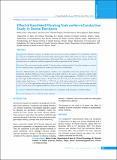Please use this identifier to cite or link to this item:
https://hdl.handle.net/20.500.14356/1345| Title: | Effect of Hand Held Vibrating Tools on Nerve Conduction Study in Dental Residents |
| Authors: | Limbu, Rekha Thakur, Dilip Limbu, Nirmala Parajuli, Prakash Sharma, Shivalal Agrawal, Navin Maskey, Robin |
| Citation: | LimbuR., ThakurD., LimbuN., ParajuliP., SharmaS., AgrawalN., & MaskeyR. (2020). Effect of Hand Held Vibrating Tools on Nerve Conduction Study in Dental Residents. Journal of Nepal Health Research Council, 17(4), 451-455. https://doi.org/10.33314/jnhrc.v17i4.2177 |
| Issue Date: | 2019 |
| Publisher: | Nepal Health Research Council |
| Article Type: | Original Article |
| Keywords: | Dentists nerve conduction study vibration |
| Series/Report no.: | Oct-Dec, 2019;2177 |
| Abstract: | Abstract Background: Repetitive exposure to vibration has been shown to induce peripheral nerve dysfunction. Dentists are exposed to handheld vibrating tools in their daily clinical practice. Most of the studies are done in dentists who have symptoms such as paresthesia and numbness of the hands. Thus, we conducted the study to explore the effect of vibration on nerve conduction variables in apparently healthy asymptomatic dental residents. Methods: This cross-sectional study enrolled 22 dental residents and age matched 22 medical residents as controls. Nerve conduction study was performed in median and ulnar nerves of both hands. Results: Anthropometric and cardiorespiratory variables were comparable between the groups. There were no statistically significant differences between dental and medical residents in the sensory conduction variables (right median onset latency=2.05±0.27 vs 1.91±0.21, p value=0.07; right median amplitude =27.80±8.11 vs 29.55±7.04, p=0.45; right median conduction velocity = 59.54±7.05 vs 61.06±5.15, p= 0.42) and motor conduction variables (right median distal latency = 2.87±0.38 vs 2.87±0.38, p= 0.94; right median distal amplitude=10.71±2.19 vs 11.10±2.37, p=0.58; right median conduction velocity= 70.57±13.16 vs 68.53±7.73, p= 0.54) of median and ulnar nerves. Further, there was no significant difference between the dominant and non-dominant hands of dental residents. Conclusions: Hand held vibration tools did not alter nerve conduction study parameters of dental residents. Keywords: Dentists; nerve conduction study; vibration. |
| Description: | Original Article |
| URI: | http://103.69.126.140:8080/handle/20.500.14356/1345 |
| ISSN: | Print ISSN: 1727-5482; Online ISSN: 1999-6217 |
| Appears in Collections: | Vol. 17 No. 4 Issue 45 Oct-Dec 2019 |
Files in This Item:
| File | Description | Size | Format | |
|---|---|---|---|---|
| 2177-Manuscript-13227-1-10-20200121.pdf | Fulltext Download | 594.12 kB | Adobe PDF |  View/Open |
Items in DSpace are protected by copyright, with all rights reserved, unless otherwise indicated.
